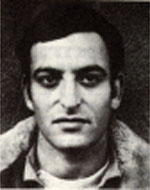Levi, son of Tirza and Emanuel, was born on January 15, 1947 in Kibbutz Ein Hamifratz near Acre. He studied in the elementary grades of the kibbutz and when he was twelve he moved to the Na’aman educational institution. Levy began as a young boy, interested in “flying machines” and the people who operated them. He built a lot of models, and eventually began to know gliders and even real airplanes. Even in his youth there were signs of real boyish mischief, and his attitude toward things was always personal – nonconformist. At the same time, he excelled in a serious approach, deep and sincere in his relationships with children his age, and with adults alike. While studying at the educational institution, Levy joined the Gadna Air Force, and when he completed his studies he was chosen to represent Israel in an exchange of air-to-air exchanges with the United States, where he traveled with his friends at various bases, As a finalist at the Na’aman Institute, he chose to build an air tunnel for aerodynamic experiments, and Levy was gifted with the ability to penetrate and investigate in depth, and in every field he encountered – at work, in the agriculture, and in friendly relations with his friends And his parents remember his conversations with him, conversations that were marked by maturity and personal integrity, and Levy joined the IDF in mid-November 1965 and volunteered The Air Force. After passing the entrance exams for an aviation course, he completed basic training and continued with the course until they successfully completed two years later. After spending a short time in the Uragans squadron, he returned to the flight school, this time as a guide, again for a period of two years. Despite his mischievousness at the time he was an apprentice, Levy was considered tough and uncompromising. He received warm and admiring assessments from his commanders, despite his rebellious nature, and his unconventional approach to the problems posed to him. At the end of the training period, he was a pilot at the Supermister and later took a Phantoms course – which he loved very much. Despite his success, Levy was full of doubts about his future in life. He signed his signature on the continuation of his service with the Israel Defense Forces, and made a year of vacation in the kibbutz. This was how his deep connection with his home and friends was expressed. During this year he worked in the kibbutz garage and became involved in work and society. When he repaired and assembled machines, he did it again with his characteristic devotion and curiosity. During this period he was also very active in the cultural life of the kibbutz, conceived brilliant initiatives and ideas and was able to organize parties and holidays for the pleasure of all members. This year he married Gilo his girlfriend, and her son is a house full of understanding and deep love. At the end of the vacation year, the two went to live in one of the IAF bases to continue his service. He began planning his long-term future in the Air Force, and therefore agreed to “get off” in the type of plane – from Phantom to Skyhawk – in order to rise to the command ladder and be appointed deputy squadron commander. During the Yom Kippur War, Levy, as deputy commander of the squadron, took part in the braking battles in the Golan Heights and in Sinai. His fighting in these battles earned him a commendation from the Commander of the IAF, describing the way he fought and died: “On the 7th of Tishrei 5740 (7.10.1973), after a day of fighting and a long night of rest, The squadron’s battle had a dangerous immediate mission: to attack the Egyptian bridges on the Suez Canal. Despite his fatigue, he took off the attackers’ head. He carried out his mission under heavy anti-aircraft fire and in the Lev of an area protected by enemy missiles. Levy was brought to rest in the cemetery on Kibbutz Ein Hamifratz, where he left behind a wife, parents and two brothers, and was promoted to the rank of major. About his character and a selection of his letters.
